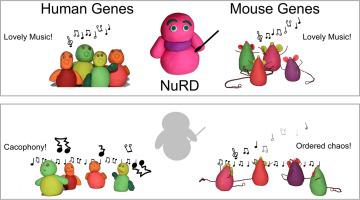Stem Cell Research ( IF 1.2 ) Pub Date : 2020-06-03 , DOI: 10.1016/j.scr.2020.101867 Ramy Ragheb 1 , Sarah Gharbi 1 , Julie Cramard 1 , Oluwaseun Ogundele 1 , Susan L Kloet 2 , Thomas Burgold 1 , Michiel Vermeulen 3 , Nicola Reynolds 1 , Brian Hendrich 4

|
Differentiation of mammalian pluripotent cells involves large-scale changes in transcription and, among the molecules that orchestrate these changes, chromatin remodellers are essential to initiate, establish and maintain a new gene regulatory network. The Nucleosome Remodelling and Deacetylation (NuRD) complex is a highly conserved chromatin remodeller which fine-tunes gene expression in embryonic stem cells. While the function of NuRD in mouse pluripotent cells has been well defined, no study yet has defined NuRD function in human pluripotent cells. Here we find that while NuRD activity is required for lineage commitment from primed pluripotency in both human and mouse cells, the nature of this requirement is surprisingly different. While mouse embryonic stem cells (mESC) and epiblast stem cells (mEpiSC) require NuRD to maintain an appropriate differentiation trajectory as judged by gene expression profiling, human induced pluripotent stem cells (hiPSC) lacking NuRD fail to even initiate these trajectories. Further, while NuRD activity is dispensable for self-renewal of mESCs and mEpiSCs, hiPSCs require NuRD to maintain a stable self-renewing state. These studies reveal that failure to properly fine-tune gene expression and/or to reduce transcriptional noise through the action of a highly conserved chromatin remodeller can have different consequences in human and mouse pluripotent stem cells.
中文翻译:

通过核小体重塑和去乙酰化复合物,在人和小鼠引发的多能干细胞中对血统承诺的差异调节。
哺乳动物多能细胞的分化涉及转录的大规模变化,并且在协调这些变化的分子中,染色质重塑剂对于启动,建立和维持新的基因调控网络至关重要。核小体重塑和去乙酰化(NuRD)复合物是高度保守的染色质重塑剂,可微调胚胎干细胞中的基因表达。尽管已经清楚地定义了NuRD在小鼠多能细胞中的功能,但是还没有研究定义在人多能细胞中的NuRD功能。在这里,我们发现虽然NuRD活性是人类和小鼠细胞中启动多能性的谱系承诺所必需的,但此要求的性质却令人惊讶地不同。小鼠胚胎干细胞(mESC)和表皮干细胞(mEpiSC)要求NuRD维持适当的分化轨迹(通过基因表达谱判断),而缺少NuRD的人诱导多能干细胞(hiPSC)甚至无法启动这些轨迹。此外,虽然NuRD活性对于mESC和mEpiSC的自我更新是必不可少的,但hiPSC要求NuRD保持稳定的自我更新状态。这些研究表明,通过高度保守的染色质重塑剂的作用,无法正确微调基因表达和/或降低转录噪音可能会对人和小鼠多能干细胞产生不同的后果。NuRD活性对于mESC和mEpiSC的自我更新是必不可少的,而hiPSC则要求NuRD保持稳定的自我更新状态。这些研究表明,通过高度保守的染色质重塑剂的作用,无法正确微调基因表达和/或降低转录噪音可能会对人和小鼠多能干细胞产生不同的后果。NuRD活性对于mESC和mEpiSC的自我更新是必不可少的,而hiPSC则要求NuRD保持稳定的自我更新状态。这些研究表明,通过高度保守的染色质重塑剂的作用,无法正确微调基因表达和/或降低转录噪音可能会对人和小鼠多能干细胞产生不同的后果。



























 京公网安备 11010802027423号
京公网安备 11010802027423号